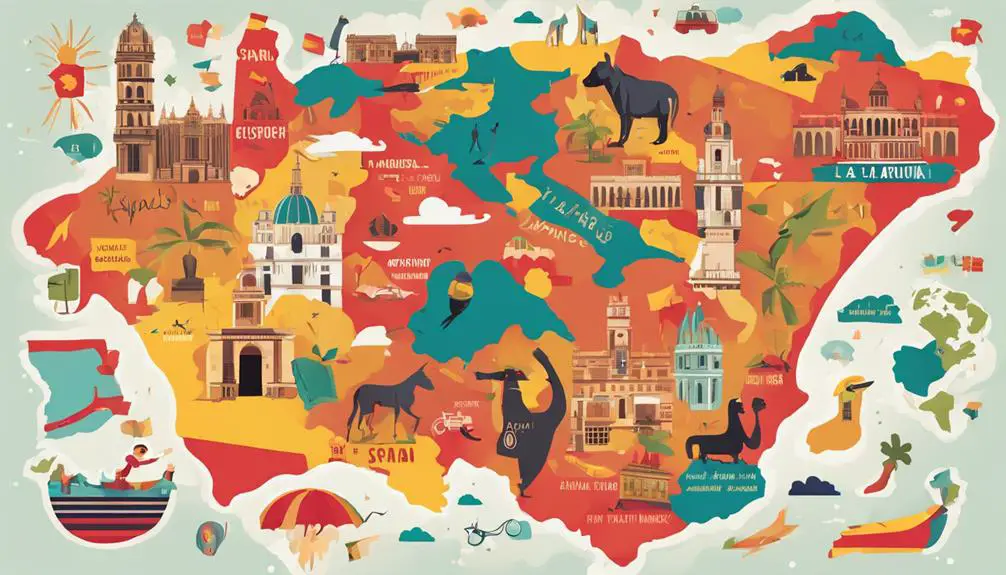When you interpret English to Spanish slang, you're not just maneuvering through a landscape of cultural nuances, regional dialects, and colloquial expressions that can make or break your connection with native speakers. You'll need to take into account the diverse dialects, cultural norms, and regional flavors of Spanish slang to communicate confidently. Mastering idiomatic expressions, formal and informal language, and avoiding offensive phrases will help you connect authentically with native speakers. As you explore the intricacies of Spanish slang, you'll discover the keys to opening meaningful connections and navigating everyday conversations like a native.
Understanding Spanish Slang Basics

When you delve into the world of Spanish slang, you'll quickly realize that it's not just about tossing in a few trendy words and phrases, but rather about understanding the cultural context and nuances that give slang its power and authenticity.
You'll discover that Spanish slang is deeply rooted in the country's diverse dialects, each with its unique flavor and flair. From the vibrant streets of Madrid to the laid-back beaches of Argentina, every region has its distinct slang vocabulary.
To truly grasp Spanish slang, you need to appreciate the cultural nuances that shape its usage. For instance, in some Latin American countries, certain words can have different meanings or connotations depending on the context and speaker's intention.
Understanding these subtleties will help you navigate the complex world of Spanish slang with confidence. By doing so, you'll be able to connect with native speakers on a deeper level, and express yourself with authenticity and flair.
Common English Idioms in Spanish
As you explore the world of Spanish slang, you'll find that many English idioms have direct translations or equivalents in Spanish, allowing you to convey nuanced ideas and emotions with precision and authenticity.
Mastering idiom equivalents is essential to avoid cultural miscommunication. For instance, 'break a leg' translates to 'buena suerte' (good luck), not 'romper una pierna' (break a leg, literally!). Similarly, 'call it a day' becomes 'dejarlo para mañana' (leave it for tomorrow).
Here are some common English idioms with their Spanish equivalents:
| English Idiom | Spanish Equivalent | Meaning |
|---|---|---|
| 'Cost an arm and a leg' | 'costar un ojo de la cara' | be very expensive |
| 'Bite off more than you can chew' | 'morder más de lo que puedes mascar' | take on more responsibility than you can handle |
| 'Beat around the bush' | 'andar con rodeos' | avoid talking directly or clearly |
| 'Cut to the chase' | 'ir al grano' | get to the point quickly |
| 'Practice what you preach' | 'predicar con el ejemplo' | act in accordance with your words |
Slang Expressions by Region

You'll soon discover that Spanish slang expressions vary greatly from region to region, with different countries and even cities having their own unique flavors of colloquial language. As you explore the world of Spanish slang, you'll find that regional dialects are a key factor in shaping the language.
For instance, the coastal regions of Spain, such as Andalusia and Catalonia, have a distinct flavor of slang that's often influenced by the sea and the laid-back coastal lifestyle. This is where you'll find Coastal slang, or 'costeño' slang, which is characterized by a relaxed, casual tone and a blend of Mediterranean and Atlantic influences.
In contrast, inland regions like Madrid and Castile have their own distinct slang, often influenced by the capital city's fast-paced urban culture. Meanwhile, countries like Argentina, Chile, and Colombia have their own unique slang expressions that reflect their individual cultural identities.
As you explore further into the world of Spanish slang, you'll find that each region has its own story to tell, and understanding these regional dialects is key to mastering the nuances of the language.
Formal Vs Informal Language
In your interactions with Spanish speakers, mastering the distinction between formal and informal language is vital, as it can make or break the tone and effectiveness of your communication.
You see, in Spanish culture, language is deeply tied to social hierarchy and relationships, and using the wrong level of formality can be misinterpreted or even offend. This Language Hierarchy is pivotal to grasp, as it can affect the way your message is received.
When speaking with someone you don't know well, or someone in a position of authority, it's necessary to use formal language (e.g., 'usted' instead of 'tú'). This shows respect and avoids coming across as too casual or familiar.
On the other hand, with friends or peers, informal language is the norm. Cultural Nuances play a significant role here, as what's considered respectful in one region might be seen as too formal in another.
Avoiding Offensive Phrases

Mastering the nuances of Spanish slang also means being aware of phrases that can unintentionally offend, as cultural norms and idiomatic expressions can vary greatly between regions and even generations. You don't want to inadvertently commit a slang faux pas, which can lead to cultural insensitivity and misunderstandings.
| Region | Slang to Avoid |
|---|---|
| Latin America | "Guapo/a" (handsome/beautiful) to refer to someone's physical appearance, as it can come across as superficial or objectifying. |
| Spain | "Chulo/a" (cool) to describe someone, as it can be perceived as flirting or overly familiar. |
| Mexico | " Güey" (dude) to address someone, as it can be seen as disrespectful or informal. |
Mastering Colloquial Conversations
As you immerse yourself in everyday conversations in Spanish, you'll want to pepper your speech with colloquial expressions that evoke a sense of familiarity and shared experience. This is where cultural immersion comes in – by surrounding yourself with native speakers, watching Spanish TV shows, and listening to Latin music, you'll pick up on the nuances of conversational flow.
You'll start to notice how locals use slang to add flavor to their conversations, making them sound more relaxed and informal. To master colloquial conversations, focus on incorporating idiomatic expressions, like '¿Qué onda?' (what's up?) or '¡Hasta luego, cuñado!' (see you later, buddy!).
These phrases will help you connect with native speakers on a deeper level, making your interactions feel more authentic and spontaneous. Remember, the goal is to sound natural, not like a textbook.
Online Resources for Slang Translation

You can tap into a wealth of online resources that specialize in translating English slang into Spanish, helping you navigate the nuances of colloquial language with greater accuracy.
One of the most reliable options is online dictionaries that cater specifically to slang translation. Websites like SpanishDict and WordReference offer extensive databases of slang terms, phrases, and idioms, complete with examples and context.
You can also utilize language apps like iTranslate and TripLingo, which provide access to slang dictionaries, phrasebooks, and even audio pronunciation guides. These resources are especially useful when you're unsure of the cultural context or regional variations of a particular slang term.
By leveraging these online resources, you'll be better equipped to communicate effectively with native Spanish speakers and avoid cultural faux pas.
Whether you're a language learner, traveler, or business professional, these tools will help you stay on top of the latest slang and colloquialisms, ensuring your interactions are authentic and respectful.
Frequently Asked Questions
Can I Use Google Translate to Learn Spanish Slang?
You're wondering if Google Translate can help you learn Spanish slang? While it's a great starting point, it has its significance. Google Translate mightn't grasp cultural nuances, idioms, or colloquial expressions, which are important in slang.
It's like trying to understand a joke without context. You'll get the words, but not the essence. To truly learn Spanish slang, immerse yourself in the culture, listen to native speakers, and practice with language exchange partners.
That's where the real learning happens!
How Do I Know When to Use Formal or Informal Language?
When communicating in Spanish, you'll need to navigate formal and informal language. To do this, consider the cultural norms and language context.
Are you speaking with a friend or a superior? In formal situations, use 'usted' and formal verb conjugations. Informal language is for close friends and family, using 'tú' and informal verb forms.
Pay attention to your audience and adjust your language accordingly. Remember, cultural nuances can vary across countries, so be aware of local customs and adapt your language to show respect.
Are There Differences in Slang Between Latin American Countries?
When you venture into the vibrant streets of Latin America, you'll discover a rich tapestry of cultural nuances that weave together to create a unique slang identity for each country.
You'll find that regional dialects, shaped by history, geography, and social dynamics, have given birth to distinct slang styles.
For instance, Mexico's 'chilango' slang is vastly different from Argentina's 'lunfardo.'
Can I Learn Spanish Slang From Watching TV Shows and Movies?
You're wondering if watching TV shows and movies can help you learn Spanish slang. Absolutely! Cultural immersion is key, and authentic dialogue in shows and movies can give you a taste of how slang is used in everyday conversations.
Just remember to pay attention to the context and region-specific expressions. You'll pick up on colloquialisms and idioms that'll make your Spanish sound more natural and relatable.
Is It Rude to Use Slang With Someone You Don't Know Well?
'When in Rome, do as the Romans do' is a great motto to remember when communicating with someone you don't know well. Using slang with someone you've just met can come across as overly familiar or even rude.
Be mindful of cultural norms and social boundaries. You don't want to unintentionally offend or make the other person uncomfortable. Stick to more formal language until you've established a rapport and can gauge their comfort level with slang.
Conclusion
¡Eres un pro! You've finally mastered the art of translating English to Spanish slang. But, beware – with great power comes great responsibility.
Don't get too comfortable, or you'll end up sounding like a gringo trying too hard. Remember, the key to fluent slang is to use it with finesse, not to overdo it.
Now, go forth and speak like a native – or at least, don't embarrass yourself.







